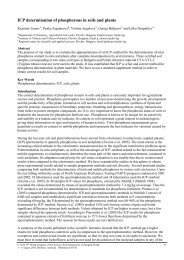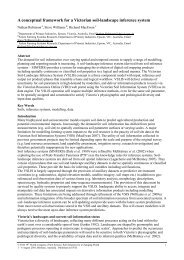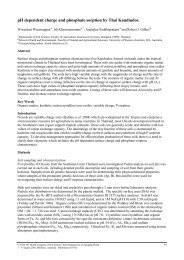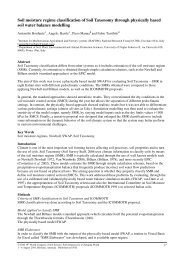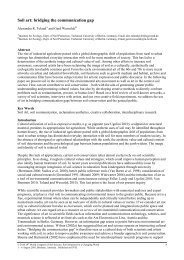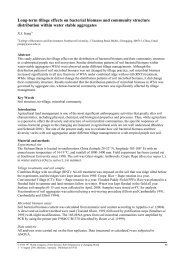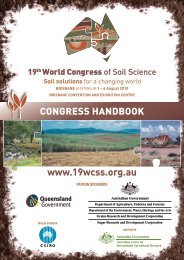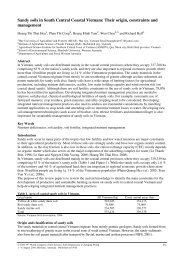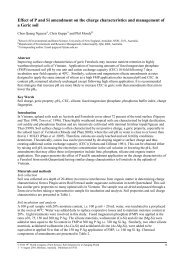Pillai-McGarry Usha
Pillai-McGarry Usha
Pillai-McGarry Usha
You also want an ePaper? Increase the reach of your titles
YUMPU automatically turns print PDFs into web optimized ePapers that Google loves.
Soil factors affecting vegetation establishment after sand mining on North<br />
Stradbroke Island<br />
<strong>Usha</strong> P. <strong>Pillai</strong>-<strong>McGarry</strong> A , Craig Lockhart B and David Mulligan A<br />
A The University of Queensland, Sustainable Minerals Institute, Brisbane, QLD, Australia, Email u.pillaimcgarry@uq.edu.au<br />
B Consolidated Rutile Ltd, North Stradbroke Island, QLD, Australia, Email Craig.Lockhart@consrutile.com.au<br />
Abstract<br />
A study was undertaken to investigate causes for poor native vegetation establishment and erosion in<br />
rehabilitated sand dunes following sand mining at North Stradbroke Island, Australia. The problem was<br />
mainly associated with the use of topsoil from old rehabilitated sites from earlier mining ventures<br />
(designated as pre-mined topsoil) as opposed to using topsoil from unmined native areas (designated as<br />
unmined topsoil). The approach was to characterise the soil properties pertinent to soil erosion and measured<br />
poor plant growth from two rehabilitated areas of similar age but using the different topsoils, pre-mined and<br />
unmined. Results indicated that the greatest soil physical difference between the topsoil areas was the<br />
severity and frequency of water repellency (ratings 6-severe and 5- moderate to severe) that occurred in the<br />
pre-mined topsoil. Ca and Mg contents were also lower in the pre-mined topsoil area compared to that of the<br />
unmined topsoil, as was the lower Ca:Al ratio (
Methods<br />
Fifteen trenches (1m x 2m x 1.5 m deep) were mechanically dug in two areas that were rehabilitated in 2006<br />
and managed in a similar manner. Nine of the trenches (T1 to T9) were located in the area where pre-mined<br />
topsoil was used (designated as Block A) and six (T10 to T16) in the area where unmined (native) topsoil<br />
was used (designated as Block B).<br />
Field sampling and measurements<br />
At each trench, the following field measurements and observations were undertaken:<br />
(i) Site and soil description- visual estimates of vegetation type and percent cover, slope and aspect and basic<br />
soil description (McDonald et al. 1990) to 1 m depth of a freshly exposed vertical face; (ii) three replicated<br />
soil samples were collected at 0.05 m intervals to 0.2 m, at 0.1 m intervals to 0.4 m and 0.2 m intervals to 1<br />
m depth, transported to the laboratory, air-dried and prepared for analysis by passing through a 2 mm sieve;<br />
(iii) four replicated cores for bulk density determination (70 mm dia. x 60 mm or 20 mm long) were<br />
vertically inserted at each of 0 m, 0.03 m, 0.06 m, 0.15 m, 0.3 m, 0.5 m, and 0.7 m depths using hand<br />
pressure applied to a flat stainless steel plate, placed on top of the core, the core with soil was excavated with<br />
a knife, soil oven-dried (105 o C) in the laboratory and bulk density calculated using core volume; (iv) water<br />
repellency of the surface soil was tested and rated using the water drop penetration test (WDPT) (NSW<br />
Department of Sustainable Natural Resources 2005) by placing a droplet of de-ionised water, using a 10 mL<br />
syringe, onto the soil surface bounded by a steel ring (70 mm dia. x 20 mm long) inserted into the surface,<br />
and time for penetration recorded. Five replicated readings were made so that a range of penetration times<br />
were obtained.<br />
Laboratory analyses<br />
The aim of the laboratory analyses was to provide a comparison of soil fertility from the different<br />
rehabilitation sites for use as a possible indicator for plant growth differences. All chemical analyses except<br />
for total carbon were carried out on the 50 mm dia.) roots in the 0-0.15 m depth (mainly associated with adjacent plants of<br />
A.concurrens) while finer roots were found at deeper depths where conditions were generally moister.<br />
© 2010 19 th World Congress of Soil Science, Soil Solutions for a Changing World<br />
1 – 6 August 2010, Brisbane, Australia. Published on DVD.<br />
49
Although the topsoil was less dense to ~0.35 m (related to where the subsoil commenced) in Block B, there<br />
was no significant difference in bulk density for comparable depths between Blocks (Figure 1). The gradual<br />
increase in bulk density below the 0.1m depth was associated with the hard-setting layer and a decrease in<br />
rooting density and porosity in this layer. The lower bulk density in Block B may be associated with the<br />
better plant establishment and root growth contributing to improved porosity.<br />
LSD<br />
Figure 1. Mean dry bulk density profile of the soils in Blocks A (●) and B (■). LSD (P1 in the topsoil compared to Block B where ratios were > 1.<br />
Surprisingly, % total C was low for all soils (
Table 1. Means of selected soil chemical properties of the soils in Blocks A and B at six depths.<br />
Means with similar lettered superscript are not significant at P



